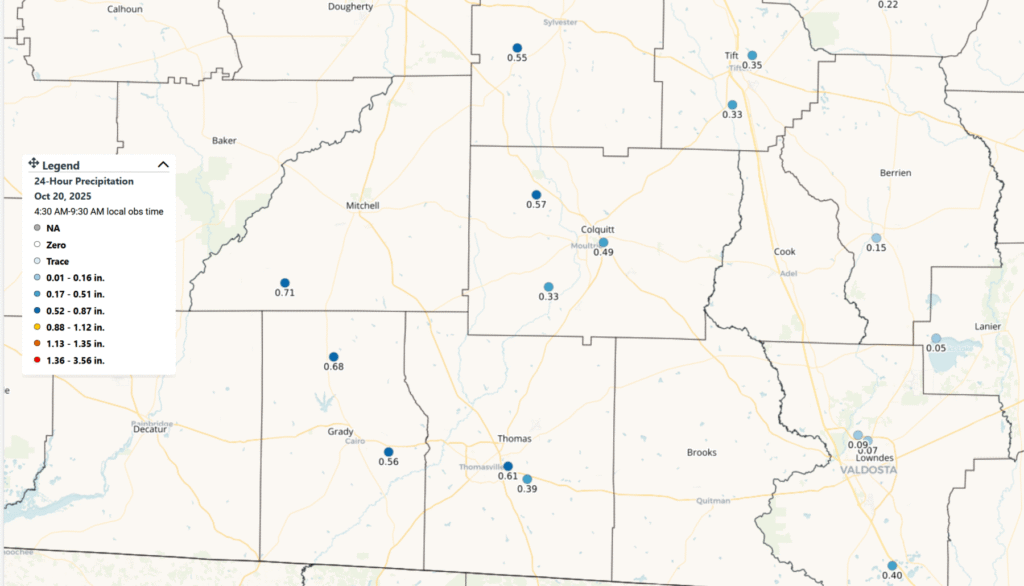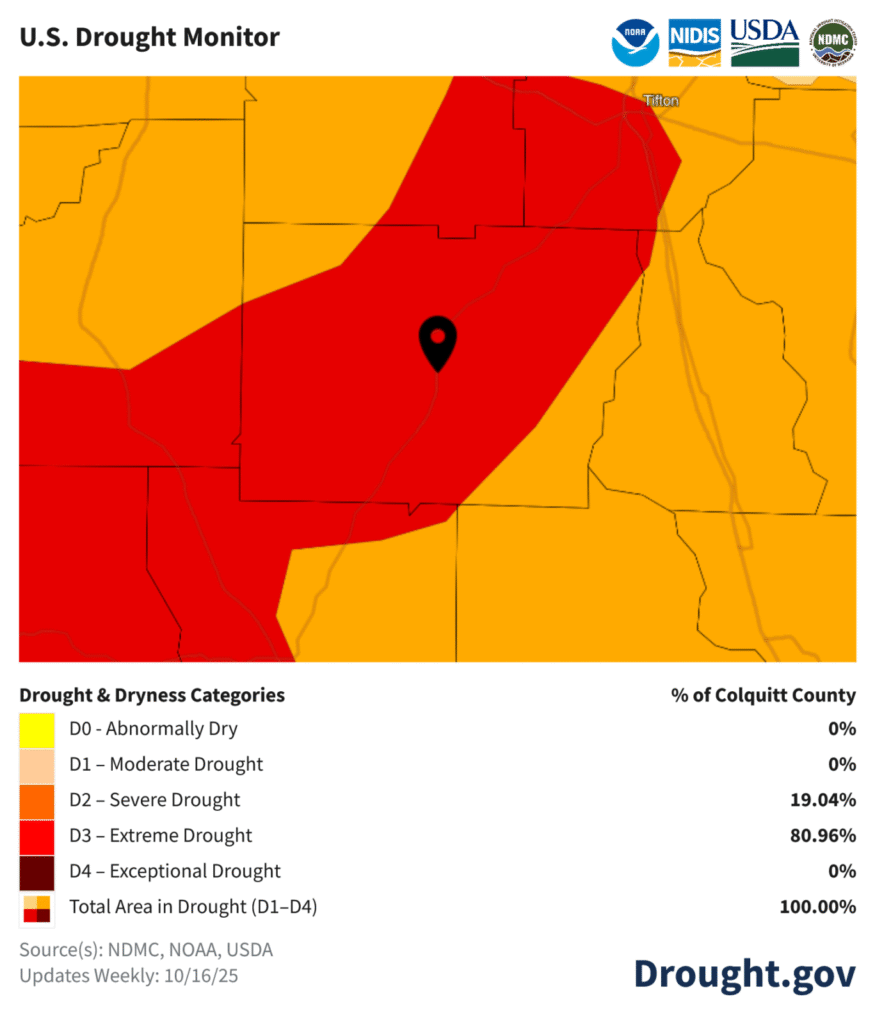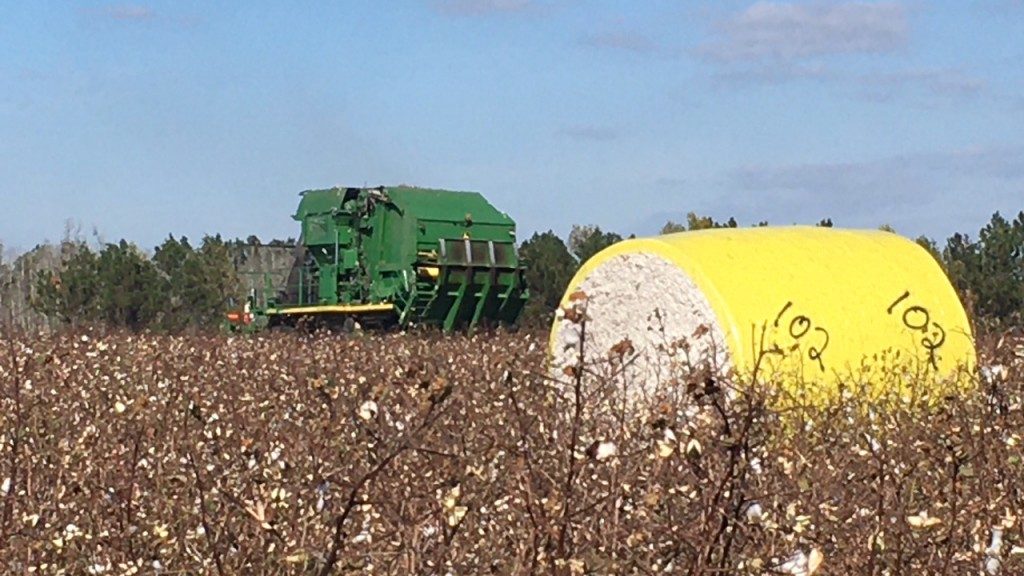Growers are busy harvesting cotton and peanuts. Rainfall totals from yesterday are shown below from the Cocorahs website. Cooler temperatures are in the forecast for this week. Below, Dr. Hand provides his insights on defoliation rates.

The Drought Monitor was released on October 16, 2025. The data shows that 80% of Colquitt County is in extreme drought. This is impacting digging dryland peanuts and establishing winter annual forages. The seasonal forecast is for dry conditions to persist into January 2026. Cocorahs data from Extension office in Moultrie show that we are 67% of normal for October rainfall, and 79% normal for the year to date.

Below is information from Dr. Wes Porter on estimating harvest losses for peanut.
Estimating Harvest Losses for Peanut
While there is a lot of information out there on harvest losses for peanut and a few ways to estimate it, some of the methods can be a bit confusing. Hopefully, this helps clarify it some.
In the roughest and most simple check, from a few sources you can estimate that each pod lost per row foot is equal to about 40 lb/ac in runner type peanuts (and 60 lb/ac in Virginia type). While this gives you a quick estimate, I strongly recommend measuring out a known area and collecting the pods from that area, checking them for actual sound mature kernels, pops, etc. This year we have been observing more pops on the ground making it appear like there are a lot of lost peanuts, it is critical that you verify this.
Thus, measure out a known length and width of row, collect fully mature pods from this area, and weigh the pods. You should account for moisture content to get a final weight.
Moisture content formula:

Take the final weight over the area collected and plug it into the following formula:

Where this can become difficult is if you are collecting this information from a windrow that is not the entire width of the original harvest area. In this case, it’s best to either take the entire width of the new windrow from the harvester and assume that it is the total harvest width (6 rows or 18 ft in most cases) or scale a smaller area. It should also be understood that some of the loss can be coming from either the header or the entire machine. The wider the area you collect the more accurate.
Once you have determined losses, it is time to start considering if you should make any combine adjustments. A few other resources can be found here for estimation of losses.
Peanut Loss Calculator – Kelley Manufacturing (kelleymfg.com)
Peanut Yield Estimator (clemson.edu)
Cotton defoliation recipe from Dr. Camp Hand.
Statewide, looks like clear weather with highs in the 70s, lows in the 40s to 50s. Beautiful weather for defoliation and harvest.
In terms of rates, below is what I’m thinking:
Thidiazuron – 2 to 4 oz/acre – all dependent on how quickly your growers will to the field for harvest. I think this product improves the efficacy of the entire tank, so I don’t want to completely remove it just yet.
Folex – 12 to 14 oz/acre – can back off to 10 on warmer days this week but higher rates are going to be necessary as temps go down.
Ethephon – 32 to 42 oz/acre – cooler temps, higher rates.
We are getting to the point of the year where I may consider a Ginstar/Adios/Cutout + Ethephon tank-mix – I’d be looking at probably 6 to 7 oz/acre of Ginstar this week (I’d go up to 8 but some people don’t like that – if you have growers that aren’t scared 8 is a great rate).
Of course, PPO herbicides are still an option and worth considering in certain situations.
Pecan Harvest Update/Hot, Dry Conditions Following Kernel Fill Can Lead to Pecan Problems
Written by Lenny Wells October 16, 2025
The pecan harvest season is underway and so far, the Pawnee harvest has been light . Even where trees appeared to have a good crop load, the wagons are weighing light with a fair amount of stick-tights and pops blowing out at the cleaning plants. This has been a common occurrence throughout much of Georgia. The most likely culprit for this is the extended cloudy, rainy conditions we had throughout much of the growing season, followed by severe drought. While size has been off or variable in some orchards, quality of the Pawnee nuts in terms of color and percent kernel have largely been excellent for those nuts that have made it through the cleaning process. READ MORE
Beefonomics: Cattle Market Update
Fall Market Update
Dr. Will Secor
While slaughter steer prices have come down from recent highs in late summer, feeder cattle prices remain elevated. These strong feeder cattle prices, particularly at lighter weights defy seasonal trends that typically see lows placed in the fall. Click below to learn more about current cattle market conditions. Read more.
Have a safe week and if you have questions please call the office,
Jeremy M. Kichler
Colquitt County Extension Coordinator
The University of Georgia Cooperative Extension does not endorse or guarantee the performance of any products mentioned in this update
